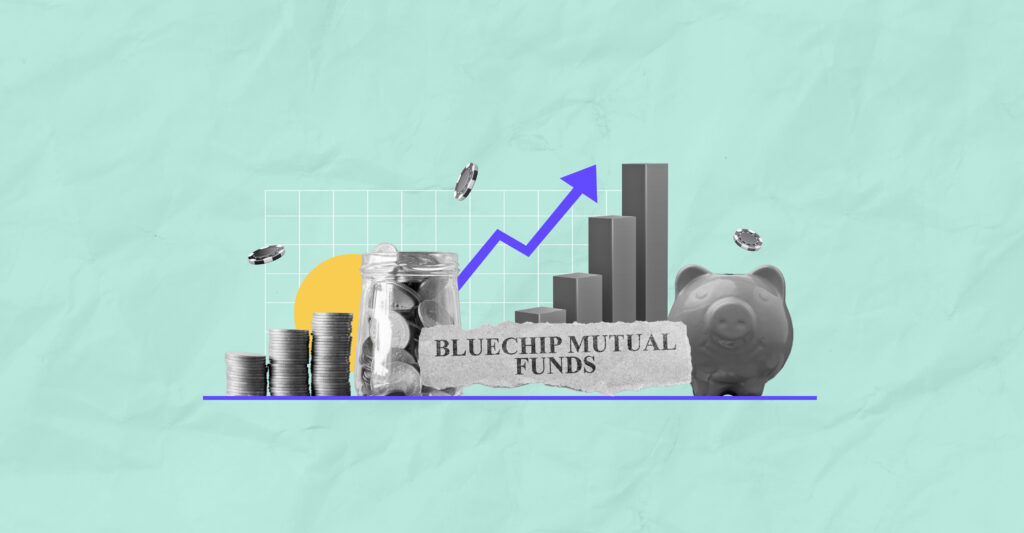Last Updated on Oct 25, 2024 by Vanessa Sequeira
Blue chip mutual funds have emerged as a reliable investment option, especially in India, where market volatility has become a recurring theme. With recent trends showing a steady rise in the popularity of bluechip funds, particularly through SIP (Systematic Investment Plan) options, many are turning to these funds to build a robust, future-proof portfolio. In this blog, we’ll explore the best blue chip mutual funds in India for 2024, helping you make informed decisions in line with the latest market trends.
Table of Contents
What Is a Bluechip Mutual Fund?
Bluechip mutual funds are a type of equity fund. According to the Securities and Exchange Board of India (SEBI), bluechip mutual funds must invest a minimum of 80% of their total assets in equity and related securities of large-cap companies. They provide relatively stable returns than small- and mid-cap funds. Hence, they are preferred by risk-averse investors.
The terms large-cap funds and bluechip funds are often used interchangeably because they both invest in large-cap companies.
Best Blue Chip Mutual Funds Based on 3-Yr CAGR
| Name | AUM (Rs. in cr.) | CAGR 3Y (%) | CAGR 5Y (%) |
| Nippon India Large Cap Fund | 34,432.09 | 20.07 | 21.96 |
| ICICI Pru Bluechip Fund | 66,206.57 | 17.70 | 21.05 |
| HDFC Top 100 Fund | 38,683.63 | 17.39 | 19.54 |
| JM Large Cap Fund | 429.06 | 17.35 | 19.99 |
| Baroda BNP Paribas Large Cap Fund | 2,439.97 | 16.72 | 19.91 |
| DSP Top 100 Equity Fund | 4,456.73 | 16.38 | 17.20 |
| Edelweiss Large Cap Fund | 1,122.58 | 15.91 | 19.99 |
| Invesco India Largecap Fund | 1,289.72 | 15.28 | 20.66 |
| Bandhan Large Cap Fund | 1,744.59 | 14.94 | 19.47 |
| HSBC Large Cap Fund | 2,039.13 | 14.50 | 18.44 |
Note: The list of best blue chip mutual funds is curated using Tickertape Mutual Fund Screener on the date 23 October 2024 by using the following parameters –
- Category: Equity > Large-cap
- Plan: Growth
- 3-yr CAGR: Sorted from highest to lowest
- 5-yr CAGR
Best Blue Chip Mutual Funds Based on Volatility
| Name | AUM (Rs. in cr.) | Volatility (%) | Tracking Error | Absolute Returns – 6M (%) |
| JM Large Cap Fund | 429.06 | 16.45 | 5.49 | 10.02 |
| ITI Large Cap Fund | 370.01 | 16.45 | 4.76 | 6.48 |
| Bank of India Bluechip Fund | 198.82 | 15.74 | 4.52 | 6.13 |
| Quant Large Cap Fund | 2,415.88 | 15.39 | 8.07 | 3.76 |
| HSBC Large Cap Fund | 2,039.13 | 15.00 | 3.30 | 12.89 |
| Taurus Large Cap Fund | 52.90 | 14.87 | 4.03 | 10.01 |
| Union Largecap Fund | 434.87 | 14.68 | 2.98 | 7.47 |
| Groww Largecap Fund | 132.88 | 14.60 | 3.17 | 9.58 |
| Tata Large Cap Fund | 2,531.43 | 14.59 | 2.73 | 10.62 |
| WOC Large Cap Fund | 640.39 | 14.30 | 3.26 | 14.26 |
Note: The list of best blue chip mutual funds is curated using Tickertape Mutual Fund Screener on the date 23 October 2024 by using the following parameters –
- Category: Equity > Large-cap
- Plan: Growth
- Volatility – Sorted from highest to lowest
- Tracking Error
- 6M Absolute Returns
Best Blue Chip Mutual Funds Based on 1-Yr Absolute Returns
| Name | AUM (Rs. in cr.) | Absolute Returns – 1Y (%) | Alpha |
| Quant Large Cap Fund | 2,415.88 | 39.79 | 4.3 |
| Invesco India Largecap Fund | 1,289.72 | 39.03 | 3.04 |
| Baroda BNP Paribas Large Cap Fund | 2,439.97 | 39.00 | 2.96 |
| Bandhan Large Cap Fund | 1,744.59 | 38.52 | 3.92 |
| WOC Large Cap Fund | 640.39 | 38.44 | 2.6 |
| DSP Top 100 Equity Fund | 4,456.73 | 38.42 | 3.65 |
| JM Large Cap Fund | 429.06 | 36.96 | 1.35 |
| ICICI Pru Bluechip Fund | 66,206.57 | 36.77 | 2.69 |
| HSBC Large Cap Fund | 2,039.13 | 35.62 | 1.22 |
| Taurus Large Cap Fund | 52.90 | 35.29 | 1.82 |
Note: The list of best blue chip mutual funds is curated using Tickertape Mutual Fund Screener on the date 23 October 2024 by using the following parameters –
- Category: Equity > Large-cap
- Plan: Growth
- 1-yr Absolute Returns – Sorted from highest to lowest
- Alpha
Taxation on Equity Mutual Funds as per the 2024 Budget
Now that you know what are blue chip mutual funds, it’s essential to be aware of the taxation policies. The Union Budget 2024 has introduced significant changes to the taxation of equity mutual funds, simplifying the tax structure while altering rates and benefits. Here is a detailed breakdown of the new tax rules:
- Short-Term Capital Gains (STCG): If you hold equity mutual funds for less than a year, the gains from these investments are classified as short-term capital gains.
- Long-Term Capital Gains (LTCG): For equity mutual funds held for more than a year, the gains are considered long-term capital gains
| Capital Gains Tax | Holding Period | Old Rate | New Rate |
| Short-Term Capital Gains (STCG) | Less than 12 months | 15% | 20% |
| Long-Term Capital Gains (LTCG) | More than 12 months | 10% | 12.50% |
- No Indexation Benefit: This change affects the overall tax liability, potentially increasing it for long-term investors.
Features of Blue Chip Mutual Funds
If you’re searching for the best blue chip mutual fund, reviewing the top 5 blue chip mutual funds in India can give you a clear picture of which funds have consistently performed well. Here are some key features of blue chip funds:
- Stable and Reliable Returns: The best bluechip funds invest in companies that have demonstrated consistent growth over time. This makes these funds an attractive option for investors looking for steady, long-term returns.
- Lower Volatility: Given that blue chip funds primarily invest in large, well-established companies, they tend to be less volatile compared to funds that focus on mid-cap or small-cap stocks. This makes them a safer choice during market downturns.
- Dividend Payouts: Many companies in blue chip mutual funds regularly pay dividends, providing an additional stream of income for investors.
- Long-Term Growth: While bluechip funds may not offer explosive short-term gains, they are designed for steady, long-term capital appreciation. This makes them an ideal choice for investors with a long-term investment horizon.
Who Should Invest in Blue Chip Mutual Funds?
Not all investors have the same risk tolerance or financial goals, so it’s important to determine if blue chip mutual funds are suitable for your portfolio. Here’s a look at who should consider investing in these funds:
- Long-Term Investors: Bluechip funds are best suited for those with a long-term investment horizon. If you’re planning for retirement or looking to grow your wealth steadily over a decade or more, these funds can offer consistent returns with relatively lower risk.
- Moderate Risk-Takers: Investors who are not looking for high-risk, high-reward strategies will appreciate the stability of blue chip funds. While the returns may not be as high as those from small-cap funds, the risks are also considerably lower.
- SIP Investors: If you prefer a systematic investment plan (SIP), the best blue chip funds for SIP are designed to accommodate regular, smaller investments. This makes it easier for investors to build wealth over time, even with modest monthly contributions.
- Dividend Seekers: For those who want to supplement their income with dividends, many bluechip funds invest in companies that regularly pay dividends to shareholders.
Advantages of Bluechip Funds
- Bluechip funds are considered an ideal investment for long-term goals. Hence, it gives you enough time to build a healthy corpus and reach your financial goal.
- Being highly popular, the liquidity of bluechip companies is high.
- As the organisations in the bluechip companies are of high profile, they don’t generate revenue from a single channel. Hence the portfolio will be well-diversified.
- SEBI and AMFI standards ensure bluechip funds as extremely safe.
Risks Associated with Investing in Blue Chip Mutual Funds
While blue chip mutual funds are considered safer than other equity-based investments, they are not entirely risk-free. Here are some risks to be aware of:
- Market Risk: Despite their stability, bluechip funds are still subject to fluctuations in the stock market. During market downturns, the value of these funds may decline, though generally not as sharply as riskier investments.
- Sector Concentration: Some blue chip mutual funds may have a heavy concentration in specific sectors like technology or finance. If that sector underperforms, it could negatively impact the overall performance of the fund.
- Slower Growth: While bluechip funds offer more stability, their growth potential may not be as high as small-cap or mid-cap funds. Investors seeking faster growth may find the returns from blue chip funds underwhelming.
- Dividend Cuts: Although blue chip companies are known for paying dividends, there’s always a risk that companies might cut or reduce their dividend payouts in times of financial difficulty.
Factors to Consider Before Investing in Blue Chip Mutual Funds
Before you decide to invest in a bluechip fund, it’s essential to evaluate several factors to ensure it aligns with your financial goals and risk appetite. Here are some key points to consider:
- Fund Performance: Look at the historical performance of the fund, especially over long periods, to ensure it has provided consistent returns. Researching the top 10 blue chip mutual funds in India can help you narrow down your options.
- Expense Ratio: The expense ratio can significantly impact your returns over time. Compare the fees of the best blue chip mutual fund options before making your decision.
- Investment Horizon: Since blue chip mutual funds are designed for long-term growth, they are best suited for investors with a time frame of 5 years or more. If you need liquidity in the short term, other investment options may be more appropriate.
- Risk Appetite: Although bluechip funds are less volatile, they are still subject to market risks. Make sure your investment aligns with your risk tolerance.
- Fund Manager Expertise: The expertise of the fund manager can play a critical role in the performance of a fund. It’s important to choose a fund that has a track record of strong management. The top 5 blue chip mutual funds in India often have seasoned managers with a history of delivering consistent results.
By considering these factors, you can make an informed decision on which blue chip mutual funds are best suited for your financial goals. On Tickertape, you can find basic scheme information, key metrics, peer comparison, tax implications, investment checklist, fund manager portfolio, and so much more. The tool offers 50+ diverse screener filters making it simpler to locate the top mutual funds!
Conclusion
Now that you know what are bluechip funds, make sure to assess your financial goals and risk tolerance to choose the fund that works best for you. For those seeking guidance, reviewing the top 10 blue chip mutual funds in India will give you a great starting point for identifying strong performers in this category. To screen mutual funds based on different parameters, use Tickertape Mutual Fund Screener, which has over 50 filters to help you find your best mutual funds.
FAQs
1. Are blue chip funds a good investment?
Yes, blue chip funds are a good investment for long-term investors seeking stable returns from well-established companies with lower risk compared to small-cap or mid-cap funds.
2. How to choose the best blue chip mutual fund?
To choose the best bluechip mutual fund for 2024, evaluate its historical performance fund manager expertise, and compare options among the top blue chip mutual funds in India based on expense ratios and consistency in returns.
3. How long should I stay invested in a bluechip mutual fund?
Bluechip mutual funds are known to yield better returns when invested long-term. Hence, it makes sense to stay invested for at least 5-7 years. However, consider your investment objective and invest accordingly.
4. What is better in blue chip funds – lump sum or SIP?
Both approaches can work, but blue chip SIP is ideal for investors looking to spread out their investments and benefit from rupee-cost averaging, especially in volatile markets.
5. Do you need a Demat account to invest in bluechip funds?
No, you do not need a Demat account to invest in bluechip funds, as mutual fund investments can be made directly through fund houses or other platforms.
- List of Top 9 Fundamentally Strong Stocks to Buy in India - Dec 6, 2024
- Top Green Energy Mutual Funds to Watch in 2024 - Nov 8, 2024
- Best Blue Chip Mutual Funds (2024) - Oct 25, 2024




